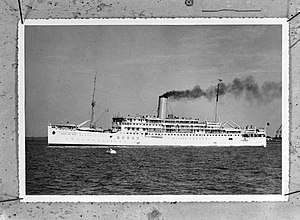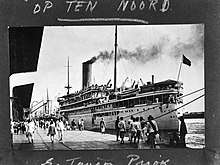SS Op Ten Noort
The SS Op ten Noort was a luxury Passenger ship built by Nederlandsche Scheepsbouw Maatschappij in Amsterdam, Netherlands and completed in 1927. The ship was built for and owned by Koninklijke Paketvaart-Maatschappij (Royal Packet Navigation Company). Op ten Noort means Up North. In December of 1941 she became a Royal Netherlands Navy hospital ship. The Empire of Japan shortly after her conversion stole the ship and renamed her Tenno Maru. Before sinking her, she was renamed again to Hikawa Maru No.2, after the Hikawa Shrine, Saitama. To cover up the war crimes against the ship and her medical crew, at the end of the war, she was sunk on August 17, 1945.[1]
 SS Op Ten Noort as passenger ship | |
| History | |
|---|---|
| Name: |
|
| Namesake: |
|
| Owner: | Koninklijke Paketvaart-Maatschappij |
| Operator: |
|
| Route: | Dutch East Indies |
| Builder: | Nederlandsche Scheepsbouw Maatschappij |
| Yard number: | 185 |
| Launched: | February 12, 1927 |
| Completed: | November 9, 1927 |
| Commissioned: | February 14, 1942 as hospital ship |
| Homeport: | Java & Amsterdam |
| Identification: | PKEA |
| Captured: | February 21, 1941 |
| Fate: | 17 August 1945 Scuttled at Wakasa Bay to cover up war crimes |
| General characteristics | |
| Class and type: | Luxury Passenger ship, then hospital ship |
| Displacement: | 6,076 long tons (6,174 t) |
| Length: | 129.5 m (424 ft 10 in) |
| Beam: | 16.8 m (55 ft 1 in) |
| Draft: | 6.7 m (22 ft 0 in) |
| Installed power: | 5 Coal boilers |
| Propulsion: |
|
| Speed: | 15 knots (28 km/h; 17 mph) |
| Boats & landing craft carried: | 14 Life boats & 2 Dinghy |
| Capacity: | 189,305 Cub ft in 3 cargo holds |
| Complement: | 130 First Class, 52 Second Class |
| Crew: | 162 |
| Armament: | none |
| Armor: | none |

%2C_Bestanddeelnr_935-3116.jpg)
.jpg)
Dutch East Indies
As a luxury Passenger ship, the Op ten Noort was put to service in the what was called Dutch East Indies, now Indonesia. Koninklijke Paketvaart Maatschappij headquarters were in Java at this time. Op ten Noort moved both passengers and cargo on the very profitable routes. On November 9, 1927 she had here maid voyage. Her 1927 route was from Singapore to Bangkok to Saigon to Manila to Maluku Island to Bali to Jakarta. After a few years the route changed to Java to Batavia to Muntok to Belawan to Deli Serdang Regency. Op ten Noort had a sister ship, the SS Plancius that operated in the South Pacific also. For fourteen years she serviced these towns as a luxury ship. The 130 First Class cabins had access to lounges, bars, smoking room and a Tropical Verandah. For the very wealthy there were two Deluxe Suites with lounge, bedroom, two bathrooms, private deck (Veranda). She had 18 Second Class 18 cabins. There was for day passenger a Tweendeck and a cafeteria.
World war 2
With the outbreak of World war 2 the SS Op Ten Noort was taken over by the Royal Dutch Navy in December of 1941 as she docked in Jakarta. There she was refit into a hospital ship. She was painted all white ship, with huge red crosses. The Dutch Government officially reported to the Japanese Ministry of Foreign Affairs at the Swedish embassy in Tokyo of the changes to SS Op Ten Noort. She was now an operational hospital ship, as thus would not be part of the war effort, that is she would not transport any weapons or active troops. On February 4, 1942 the Japanese Ministry of Foreign Affairs and Naval Ministry acknowledges Op Ten Noort status change though the Swedish embassy. On February 21, 1942, now completed, she departed on her first trip to help wounded allies. But only a few hours out of port, the Op Ten Noort was bombed by the Empire of Japan in the Java Sea. One surgeon and three nurses were killed, eleven were badly wounded. Dutch Government sent a strong note of protest of the bombing to Japan, through the Embassy of Sweden. After repairs, on 28 February 1942, she was commandeered by the Japanese destroyer Amatsukaze and Japanese destroyer Murasame near Bawean Island, stopping her rescue work again. Japanese forced her crew to transport their allies POWs to Japan POW camps. The first POW move was that of 59 POWs from the USS Perch that were on the Japanese destroyer Ushi. By the end of March 1942 she had 970 POWs, most were from the 800 survivors of HMS Exeter that sank on March 1, 1942. The prisoners of war were kept in very poor conditions and feed only a cup of rice a day, Op Ten Noort became what is called a Japanese hell ship. [2] On 20 December 1942 she was renamed the Tenno Maru an official Japanese Hospital Ship. The Dutch ship crew was taken off the ship and became POWs at Camp Myoshi, near Yokohama. Japan had signed the Hague Convention X of 1907 that stated attacking a hospital ship is a war crime.[3][4][5]
With the war coming to an end, the ship was changed in October of 1944. A second dummy smokestack was added to "hide her". She was renamed the Hikawa Maru No.2. She both served as a hospital ship and transported war cargo. For the latter part of 1944 and into 1945 she traveled from Singapore and Manila with a cargo of looted gold and other valuable Japanese conquests. The weeks before Japan surrender she arrived in Japan with gold, platinum, diamonds and gems. On August 15, 1945, the Japanese officially announce surrender. To cover up the war crimes and to hide the stolen loot, the ship was sunk on August 17, 1945, at Wakasa Bay in 400 feet of water. To sink her two 328 pound explosive charges were place in the bottom of the hull. To complete the hiding of the crime and the loot the crew that placed the bombs were killed on site. [6][7] On 17 August 1945 the ship was scuttled at Wakasa Bay by placing explosive charges in the hull, to cover up the war crimes. [8] [9]
Post war
The Netherlands thought the Op Ten Noort sank as the Tenno Maru near Makassar by a sea mine. Not knowing about the Hikawa Maru No.2 plot. In 1952 the Op Ten Noort was found after port area of Chinju Prefecture had a salvage investigations done. Professional diver from Kyoto, Mr. Shinta Koyua, photographed the wreck and it was identified as the lost Op Ten Noort. In the 1953, the Dutch Government filed 700 million Yen claim against the Japan for compensation. After years of talks, in the end 100 million Yen ($500,000) were paid to the Dutch Government in 1978. Info about the loot in the shipwreck is not public.
References
- SS Op ten Noort, plans
- Japanese POW by Alf King
- "Convention for the adaptation to maritime war of the principles of the Geneva Convention". Yale University. October 18, 1907. Retrieved August 2, 2009.
- Convention for the adaptation to maritime warfare of the principles of the Geneva Convention of 22 August 1864
- combinedfleet.com Hikawa Maru No.2
- ssmaritime.com, Royal Netherlands Navy hospital ship Op ten Nothort
- Netherlands Navy Op ten Noort
- "SS Hikawa Maru No.2 (+1945)". wrecksite. 2011. Retrieved November 9, 2011.
- "IJN Hospital Ship HIKAWA MARU NO. 2". combinedfleet.com. 2010. Retrieved November 9, 2011.